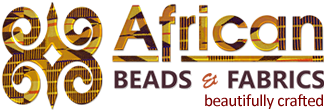Introduction
The Batik industry in Ghana has gained acceptance on local and international markets. Seen as a fashion product, new designs catch on very quickly. Another reason for its popularity is its excellent quality. In recent years, however, cheaper machine-printed imports are proving a threat to the authentic, artisan craft. In recent years many imitation batiks, some fairly attractive, have been turned out by roller printing presses and also by the silk-screen process. What you get from the good Ghanaian batik-maker, though, is a genuine pre-shrunk, hand-dyed, hand-printed fabric. No two pieces are exactly alike.
What is Batik?
Batik fabric-making is a wax-resist dyeing technique done by hand, usually in homes and small workshops by families or small groups of dealers.
What’s in the Fabric?
In the main, 100% cotton fibre is used. From cotton grown in Ghana, (the dry, Savannah climate in the northern regions of the country is ideal for the cultivation of cotton) the plain fabric is made in factories there. Either calico or grey baft is used, the former being softer. The fabric dyes, though, are imported.
The cloth is pre-shrunk, due to the dyeing and washing and re-dyeing process. Hand-dyed & hand-printed they are suitable for a wide variety of projects. Sometimes light damask fabric is used and those have a slight shimmer to the finished product. They have strong, vibrant colours with abstract or Ghanaian designs.
Who Makes Them?
We only stock genuine, artisan batik, not the cheaper, inferior imports destroying livelihoods in Africa. Most of it has come directly from the makers (4 generations of a family) who have a reputation for quality.
Made in their backyard, a little shop in the front of the home is the main retail outlet. Sadly, though, it’s a struggle to keep the business afloat because of competition from cheap mass-produced imports also labelled ‘African Fabrics’.
The Process
Melted wax is applied to the fabric in a design of the batik maker’s choice with a brush or pre-carved wooden block. Starting with a lighter colour the cloth is dipped in first dye, and then dried. Wherever the wax has seeped through the fabric, the dye will not penetrate; the rest is the new colour.
More wax is applied for the next set of designs, followed by dyeing and drying until the complete number of colours and designs has been achieved. (Often several colours are used, with a series of waxing and dyeing steps.) The fabric is boiled to remove the wax for re-use, and to reveal the deep rich colors and the fine crinkle lines that give batik its character. The last stages involve a final drying and ironing for sale.
A few of them have two designs on the same piece, meant to complement each other. One fabric is an accent to the other.
Colours and Designs
They usually have strong, vibrant colours. At the same time, there is an awareness among fabric-makers that some customers, prefer muted and softer colours, and if you know where to look, will find what you want. In Ghana, batik designs are typically floral or abstract. Symbolism in textiles is a significant part of Ghanaian culture and this has been portrayed interestingly in batik. Recent years have seen the introduction of traditional symbols such as the Adinkra into designs. Hope you can find something you love from the wide range in our web store.
Promoting National Identity
In 2004 the government of Ghana launched a “National Friday Wear Programme”, an initiative aimed at projecting a unique Ghanaian identity through the extensive use of local fabric and designs as businesswear. Workers in both the public and private sectors are encouraged to wear, as much as is practicable, clothing made from locally manufactured textiles. Batik is seen as one of those, although imports tend to be cheaper and more affordable.
What Can I Use Batik For?
It might help to know they are pre-shrunk, due to the dyeing, washing and re-dyeing process. 100% cotton, they are suitable for general sewing including:
- Clothing, including head wraps
- quilting
- curtains (with some lining if needed)
- cushion/table covers & napkins
- bags. jewellery, and so much more
How Do I Care for Ghanaian Batiks?
Machine washable at degrees Celsius (88 F) on a short cycled with mild detergent, and tumble dry on low setting. To test for colour fastness:
- dampen a small bit of your cloth
- place on a light coloured plain fabric and iron it
- If the colour has not transferred to the second cloth, your batik fabric is colour fast
Unsure of The Quality?
Don’t take our work for it, Best to let customers do the talking!:
- “Gorgeous fabric! Absolutely breathtaking… looking forward to ordering more!”
- “Absolutely gorgeous fabric. Great price. Fast delivery. Very happy thanks.”
- “Such beautiful fabric, looks just like the picture, thank you!”
Although batiks abound in Ghana, we purchased most of our stock directly from one of the best batik-makers there; she is popular with both locals and tourists because of the quality and beauty of her fabrics. You are buying excellent quality from here. They wash well and you’ll be glad you did. Many of our customers have either been pleasantly surprised at how good the cloth is or have come back to purchase more.
Our Stock
A few of the designs in our store:
- sankofa symbols in batik fabric
Your feedback about additional information to add to this section would be most appreciated.















